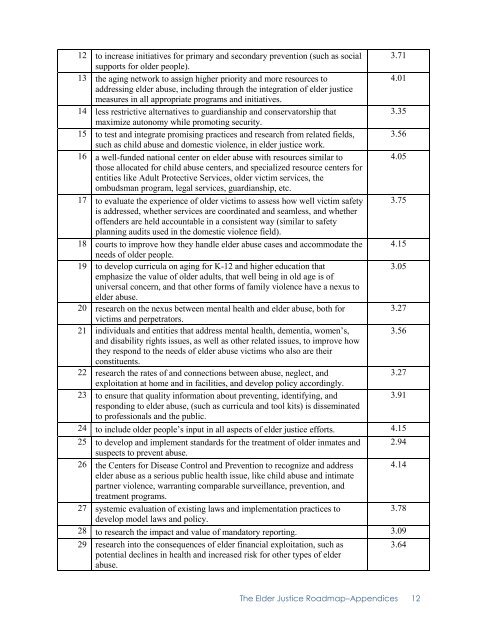The Elder Justice Roadmap
2gJRXoo
2gJRXoo
You also want an ePaper? Increase the reach of your titles
YUMPU automatically turns print PDFs into web optimized ePapers that Google loves.
12 to increase initiatives for primary and secondary prevention (such as social 3.71<br />
supports for older people).<br />
13 the aging network to assign higher priority and more resources to<br />
4.01<br />
addressing elder abuse, including through the integration of elder justice<br />
measures in all appropriate programs and initiatives.<br />
14 less restrictive alternatives to guardianship and conservatorship that<br />
3.35<br />
maximize autonomy while promoting security.<br />
15 to test and integrate promising practices and research from related fields, 3.56<br />
such as child abuse and domestic violence, in elder justice work.<br />
16 a well-funded national center on elder abuse with resources similar to<br />
4.05<br />
those allocated for child abuse centers, and specialized resource centers for<br />
entities like Adult Protective Services, older victim services, the<br />
ombudsman program, legal services, guardianship, etc.<br />
17 to evaluate the experience of older victims to assess how well victim safety 3.75<br />
is addressed, whether services are coordinated and seamless, and whether<br />
offenders are held accountable in a consistent way (similar to safety<br />
planning audits used in the domestic violence field).<br />
18 courts to improve how they handle elder abuse cases and accommodate the 4.15<br />
needs of older people.<br />
19 to develop curricula on aging for K-12 and higher education that<br />
3.05<br />
emphasize the value of older adults, that well being in old age is of<br />
universal concern, and that other forms of family violence have a nexus to<br />
elder abuse.<br />
20 research on the nexus between mental health and elder abuse, both for<br />
3.27<br />
victims and perpetrators.<br />
21 individuals and entities that address mental health, dementia, women’s, 3.56<br />
and disability rights issues, as well as other related issues, to improve how<br />
they respond to the needs of elder abuse victims who also are their<br />
constituents.<br />
22 research the rates of and connections between abuse, neglect, and<br />
3.27<br />
exploitation at home and in facilities, and develop policy accordingly.<br />
23 to ensure that quality information about preventing, identifying, and<br />
3.91<br />
responding to elder abuse, (such as curricula and tool kits) is disseminated<br />
to professionals and the public.<br />
24 to include older people’s input in all aspects of elder justice efforts. 4.15<br />
25 to develop and implement standards for the treatment of older inmates and 2.94<br />
suspects to prevent abuse.<br />
26 the Centers for Disease Control and Prevention to recognize and address 4.14<br />
elder abuse as a serious public health issue, like child abuse and intimate<br />
partner violence, warranting comparable surveillance, prevention, and<br />
treatment programs.<br />
27 systemic evaluation of existing laws and implementation practices to<br />
3.78<br />
develop model laws and policy.<br />
28 to research the impact and value of mandatory reporting. 3.09<br />
29 research into the consequences of elder financial exploitation, such as<br />
potential declines in health and increased risk for other types of elder<br />
abuse.<br />
3.64<br />
<strong>The</strong> <strong>Elder</strong> <strong>Justice</strong> <strong>Roadmap</strong>–Appendices 12


